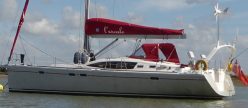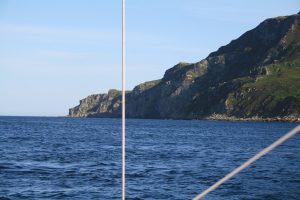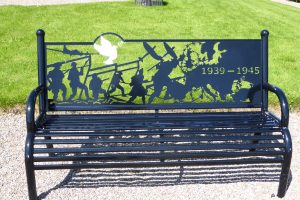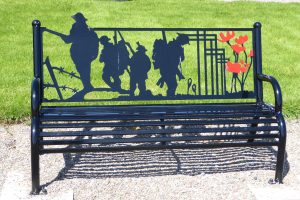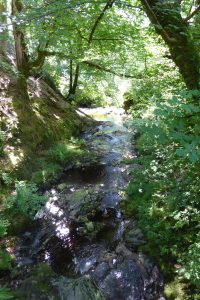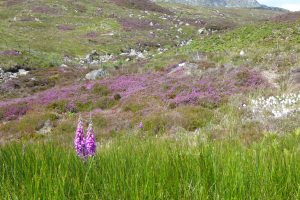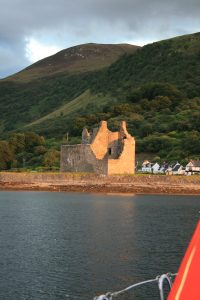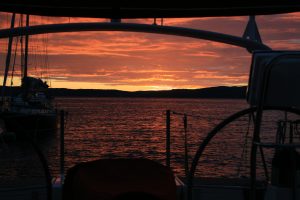Thursday 13 July
We motorsailed down Kilbrannan Sound against combined wind and tide, enjoying full main and genoa in a fairly steady F4. The crew have struggled to obtain any weather forecasts in this area, which proved unfortunate as a sudden squall blew in after lunch, and within half an hour the day had changed from sunny spells to grey drizzle and wind from six to 26 knots, veering 100˚ and rain blinding Mate and stinging her face as she struggled to steer my course for Campbeltown on the Kintyre peninsula. Fortunately, Skipper had already furled my genoa, and Mate asked for third reef in the main. It wasn’t the tidiest reef ever made, but as the only thing in our favour was that we were near a windward shore, so the waves hadn’t built, she relied on the chart plotter and radar to guide me into the bay, in mist now so dense the land had disappeared completely.
As we followed the channel between the lighthouse and the opposite headland, the gusts were still 25 knots and more, but in between 18 knots of steady breeze felt positively calm, and at least the mist started to disperse, so Mate could pick out the guiding marks. The harbour master responded to Skipper’s radio call, advising us of a berth starboard to, so he took over on the helm while Mate prepared my lines and fenders, clinging to any available handhold while the lifeboat churned out at full throttle, heading for a shout. We managed to make a clean landing, in spite of a still stiff breeze blowing us off, and then my crew helped a Czech-chartered boat into a tight alongside slot behind us, before a cursory ‘happy hour’ tidying my decks. They soon disappeared in search of fish and chips, following a recommendation to the Kilbrannon Bar on Longrow, where the barman held the kitchen open specially to prepare their order, while they were entertained in conversation with said barman, a little lady of 87 (the only other female present), delightfully away with the fairies, and three Geordie builders working at a local school, already closed for summer holidays.
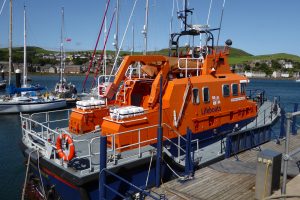 They returned home around 2200 to wash me down, refill my water tanks and wash up, distracted by the lifeboat finally returning from a five-hour shout with a tiny yacht tied alongside. The Coastguard was awaiting their return and had stern words for the miserable crew, as they were ill-prepared without proper charts or safety equipment, and the rescue services had struggled to find them in the conditions described above, which were worse on the opposite side of the peninsula, open and exposed to the full force of the Atlantic Ocean. They were finally discovered ten miles from where they’d thought they were, tangled in lobster pot lines 50 yards off rocks near Macrihanish Bay. Meanwhile the lifeboat crew made short work of thoroughly washing down their vessel, refuelling her and putting covers on, but it was still midnight before they clocked off.
They returned home around 2200 to wash me down, refill my water tanks and wash up, distracted by the lifeboat finally returning from a five-hour shout with a tiny yacht tied alongside. The Coastguard was awaiting their return and had stern words for the miserable crew, as they were ill-prepared without proper charts or safety equipment, and the rescue services had struggled to find them in the conditions described above, which were worse on the opposite side of the peninsula, open and exposed to the full force of the Atlantic Ocean. They were finally discovered ten miles from where they’d thought they were, tangled in lobster pot lines 50 yards off rocks near Macrihanish Bay. Meanwhile the lifeboat crew made short work of thoroughly washing down their vessel, refuelling her and putting covers on, but it was still midnight before they clocked off.
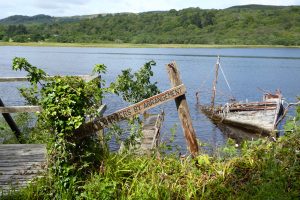 The crew decided a good leg stretch was long overdue, and puttered across to the fish quay to scramble up a ladder before following the road for a mile and a half across the isthmus into the attractive town of Tarbert, not to be confused with West Loch Tarbert, or any of the others: this is the one famous for Loch Fyne oysters and fish restaurants at least as far South as Twickenham in SW London.
The crew decided a good leg stretch was long overdue, and puttered across to the fish quay to scramble up a ladder before following the road for a mile and a half across the isthmus into the attractive town of Tarbert, not to be confused with West Loch Tarbert, or any of the others: this is the one famous for Loch Fyne oysters and fish restaurants at least as far South as Twickenham in SW London. 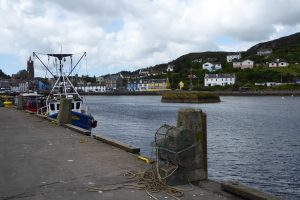 A very good lunch with local beer was enjoyed, with a view over the pretty harbour, at the Islay Frigate Hotel. The waitress had been for a run that morning and photographed a beautiful yacht lying at anchor…me! Provisions were gathered on the way home.
A very good lunch with local beer was enjoyed, with a view over the pretty harbour, at the Islay Frigate Hotel. The waitress had been for a run that morning and photographed a beautiful yacht lying at anchor…me! Provisions were gathered on the way home.